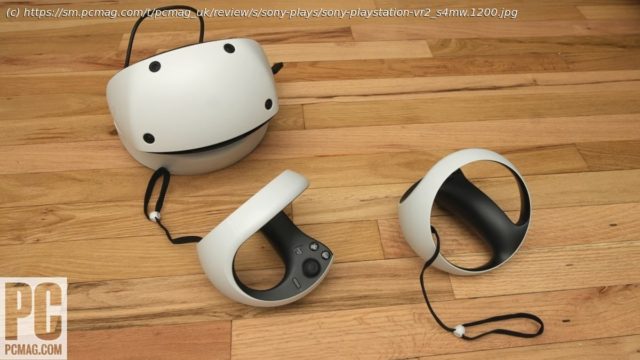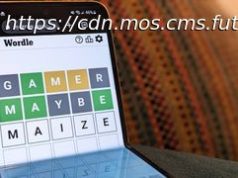The best VR headset to date
The PlayStation VR is an excellent virtual reality headset that lets PS4 owners enjoy immersive VR without a computer, but the tech has aged a lot since its 2016 release. Although Sony continues to support the platform in the PlayStation 5 era (even offering a free adapter so it works on the new console), PS VR has long needed an overhaul. The $549 PlayStation VR2 is a dramatic update designed specifically for the PS5 that uses more modern technology to improve upon nearly everything in its predecessor. It has a 4K OLED display, eye-tracking technology, and brand-new motion controllers. As a result, it offers a fantastic, easy-to-use VR experience with graphics that rival PC-tethered VR headsets. The PS VR2 is a must-have for any PS5 owner interested in virtual reality, a necessary upgrade from the previous model, and our new Editors’ Choice winner for virtual reality headsets.PS VR 2 Design and Specs
The PS VR2 headset is a curved, white visor mounted on a horizontally aligned, wraparound harness. The front of the visor features four outward-facing cameras for movement and position tracking, which is fairly standard for contemporary VR headsets. Black panels above the white one house controls for lens and scope adjustments, while function and power buttons are below. The bottom panel holds the microphone.
The headset’s face mask is covered in light rubber that serves as a gasket. The rubber is an effective light shield that keeps you immersed in the VR experience, but it doesn’t offer much padding, so there aren’t many soft surfaces between the headset and your face. Still, you can slide the visor forward or backward relative to your face using the scope adjustment button so it doesn’t get too uncomfortable.
In a nice touch, the PS VR2 accommodates people who wear glasses (such as yours truly). I wore the headset with my glasses on and didn’t experience the lenses bumping against each other or significant pressure against my face. This is aided by the headset’s relatively light weight. At just 19.8 ounces, the PS VR 2 is 1.5 ounces lighter than the PS VR, and nearly 9 ounces lighter than the Valve Index. The Meta Quest 2 weighs about 2 ounces less than the PS VR2, but it’s also a less powerful standalone headset.
The PS VR2’s headband-style harness consists of two molded, white plastic sections that pull apart and press against the front and back of your head. A ratcheting wheel with a button-release mechanism tightens the two sections together to make sure they’re secure. The headband is padded with a much more dense rubber than the face mask, so it shouldn’t pinch or poke you when properly adjusted.
A 14.7-foot-long USB-C cable is permanently attached to the bottom left side of the back of the harness. It’s joined by a 3.5mm headphone jack and a small mount hole that holds the included snap-on earphones. The earphones are simple, wired, in-canal earpieces (three pairs of eartips in different sizes are included) that dangle down from the back of the headband to fit in your ears without much wire slack. In addition, small rubber sections on the back of the headband (right above where each earphone dangles) provide a secure place to store each earpiece when not in use.
The headset packs impressive specs, including an OLED display that provides a 2,000-by-2,040-pixel picture to each eye at either 90Hz or 120Hz. It also has a 110-degree field of view, built-in vibration, and an inward-facing infrared camera for tracking your eye movements (a feature that’s usually reserved for more expensive, enterprise-focused headsets like the Meta Quest Pro). These are all solid improvements over the previous model’s specs, and they’re much welcome. However, they aren’t nearly as vital to the PS VR2 experience as the new controllers.PlayStation VR2 Sense: Finally, New Motion Controllers
It can’t be overstated how important the PS VR2 Sense controllers are to the virtual reality experience. The PS VR uses the PlayStation Move wands for motion controls, which are little more than handles with triggers and big glowing bulbs on the ends that have been in use since 2010 with the PS3. The PS VR2 Sense controllers are completely redesigned and upgraded devices that combine the Meta Quest and Meta Quest Pro controller ergonomics with the more advanced features found in Sony’s DualSense gamepad.
Each PS VR2 Sense is built around a smooth grip that contours comfortably in hand and a large white ring that wraps down and around your wrist to help the headset track its position and orientation. Like the Meta Quest controllers, each Sense unit features dual triggers that naturally rest under your index and middle fingers, letting them comfortably emulate gripping. The upper triggers are adaptive, like the DualSense triggers, providing variable resistance. Each unit also has an analog stick, two face buttons, a PlayStation button, and either an Options (for the right controller) or Create (for the left controller) button. A wrist strap extends from the ring’s interior, letting you secure the controller without much awkwardness.
The PS VR2 Sense controllers are much more ergonomic than the PlayStation Move wands, and holding them is a far more natural endeavor. However, the analog sticks sit a bit low for my hands, so I had to get used to bending my thumb a bit more than when using standard gamepads or the Meta Quest controllers. It’s a small issue, though, and one I adjusted to in little time.
Between the DualSense Edge and the PS VR2 Sense, it seems like Sony isn’t prioritizing battery life for its controllers. You might get three to four hours of use out of each Sense before needing to charge it.
The controllers charge through a USB-C port at the bottom of each grip. Unfortunately, only one USB-A-to-USB-C charging cable is included, and the front of the system only has one USB-A port (the USB-C port will presumably be taken up by the headset cable). As a result, you must use other cables and adapters to charge both controllers at once (or just charge them one at a time). PlayStation offers a $49.99 charging base that comes with its own power cable, and the unit charges both controllers at once. It includes two small adapters that plug into the Senses’ charging ports to connect to the base’s charging pins.Easy Setup and Control
Connecting and setting up the PlayStation VR2 is much simpler and easier than the first PlayStation VR. There’s no link box to run between the headset and the system, and no HDMI pass-through to manage using that box.






